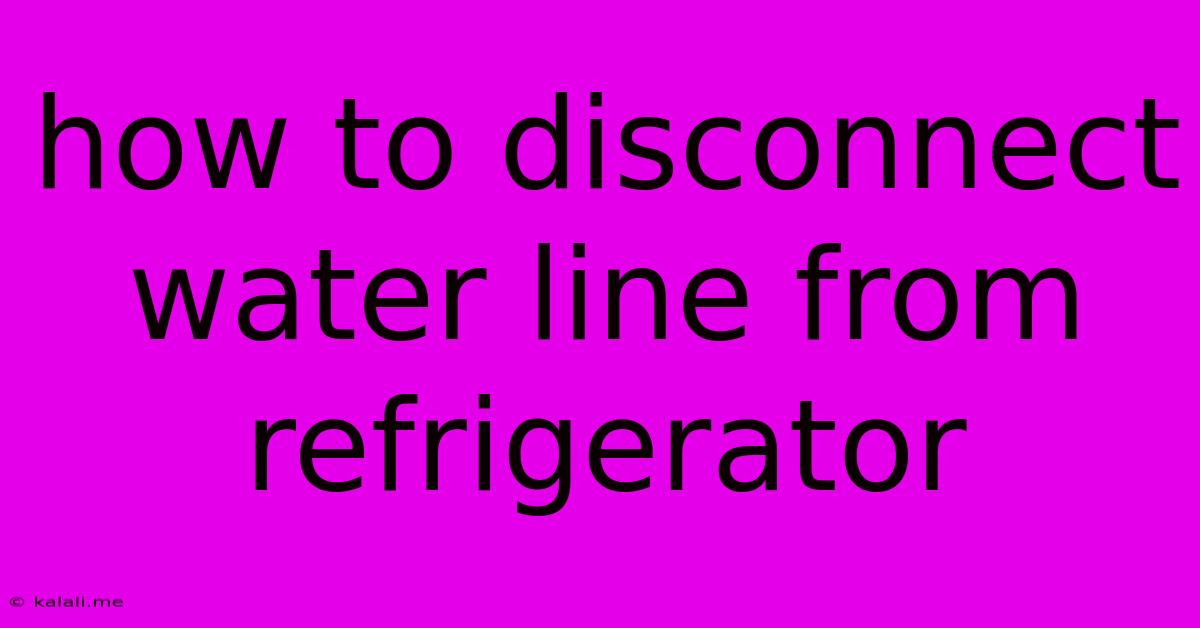How To Disconnect Water Line From Refrigerator
Kalali
May 29, 2025 · 3 min read

Table of Contents
How to Disconnect a Refrigerator Water Line: A Step-by-Step Guide
Meta Description: Learn how to safely and easily disconnect your refrigerator's water line. This step-by-step guide covers everything from shutting off the water supply to properly disconnecting the tubing. Avoid water damage and ensure a smooth appliance relocation with our helpful instructions.
Disconnecting your refrigerator's water line is a common task, whether you're relocating your fridge, replacing the water filter, or performing maintenance. While seemingly simple, improper disconnection can lead to water leaks and damage. This guide provides a clear, step-by-step process to ensure a safe and efficient disconnect.
Tools You'll Need:
- Basin or towel: To catch any spilled water.
- Container: A small bowl or container to catch any remaining water in the line.
- Adjustable pliers or crescent wrench: To loosen the water line connection. (Some lines use a quick-connect fitting that requires no tools).
Step-by-Step Disconnection Process:
-
Turn Off the Water Supply: Locate the shut-off valve for the water line supplying your refrigerator. This is usually found under the sink, near the water supply line to the refrigerator. Turn the valve clockwise to shut off the water supply completely. This is the most crucial step to prevent water damage.
-
Prepare for Water: Place a basin or towel beneath the water line connection to catch any residual water. This will prevent water from spilling onto your floor.
-
Disconnect the Water Line: The type of connection will determine how you disconnect the line.
-
Quick-Connect Fittings: These are the most common type. Simply push in the release tab (usually located on the side or top of the fitting) and gently pull the water line away from the refrigerator. A small amount of water may leak, so be prepared.
-
Compression Fittings: These require a wrench. Carefully loosen the compression nut using your adjustable pliers or crescent wrench. Gently pull the water line away from the refrigerator. Again, some water leakage is expected.
-
Other Fittings: If your refrigerator uses a different type of fitting, consult your refrigerator's manual for specific instructions.
-
-
Drain Remaining Water: Once disconnected, hold the water line over your container to drain any remaining water.
-
Reconnect (If Applicable): Once you are done with your task, carefully reconnect the water line following the reverse steps. Ensure the connection is tight and secure to prevent leaks. Remember to turn the water supply valve back on after reconnection.
Important Considerations:
- Refrigerator Model: The specific process might vary slightly depending on the make and model of your refrigerator. Always consult your owner's manual for detailed instructions.
- Water Pressure: If you experience excessive water leakage, it might indicate a problem with the water supply line or your water pressure. Consult a plumber if needed.
- Safety First: Always prioritize safety. If you are unsure about any step, it's best to consult a qualified appliance repair technician.
Troubleshooting:
- Leaking Connection: If you notice a leak after reconnection, check that the connection is securely tightened. If the leak persists, it may indicate a damaged part, requiring a repair or replacement.
By following these steps, you can safely and efficiently disconnect your refrigerator's water line. Remember that prevention is key, so always turn off the water supply before beginning any work. If you encounter any unexpected problems, it is always advisable to seek assistance from a qualified professional.
Latest Posts
Latest Posts
-
Error Self Signed Certificate In Certificate Chain
May 30, 2025
-
Javascript If Video Is Visible Then Sync
May 30, 2025
-
What Is The Red Wire For A Ceiling Fan
May 30, 2025
-
How Do You Wash Vinyl Siding
May 30, 2025
-
Integral 1 X 2 3 2
May 30, 2025
Related Post
Thank you for visiting our website which covers about How To Disconnect Water Line From Refrigerator . We hope the information provided has been useful to you. Feel free to contact us if you have any questions or need further assistance. See you next time and don't miss to bookmark.